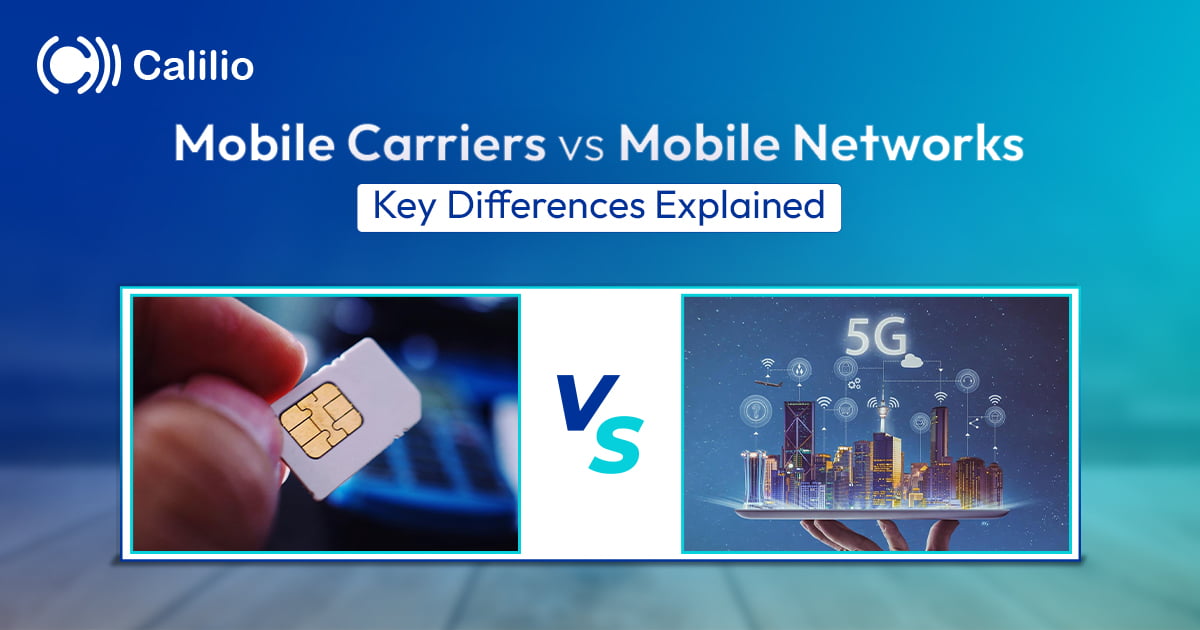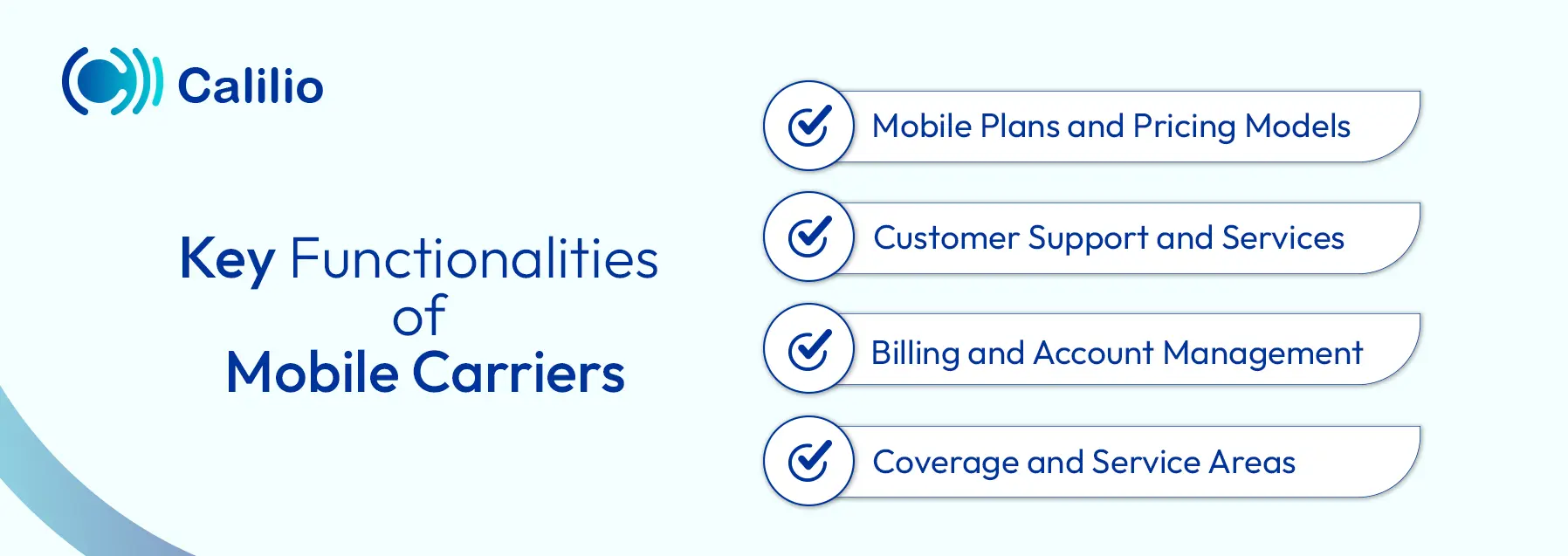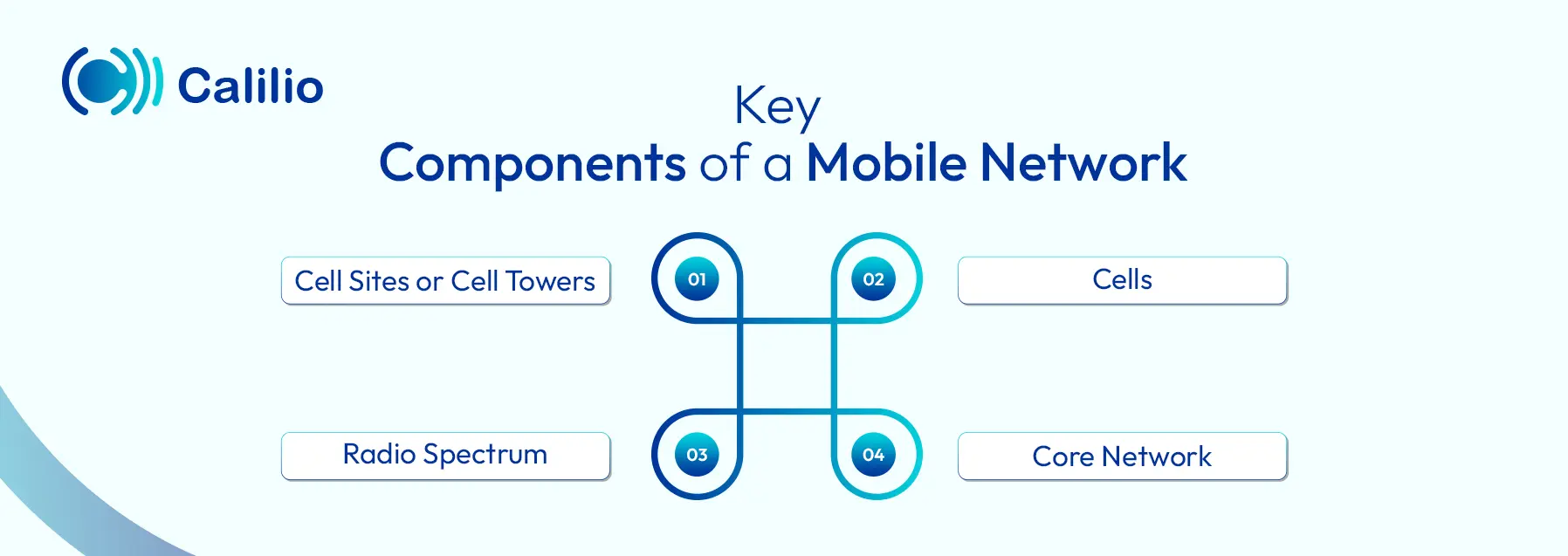Mobile Carriers vs. Mobile Networks: What’s the Difference?

Summarize this blog with:
Many phone users often use the terms mobile carrier and mobile network interchangeably. However, they are not the same thing. While they work closely together to provide your mobile service, they serve different purposes and play different roles in how your phone connects and communicates.
In this blog, we’ll explore what mobile networks and mobile carriers are in detail, alongside their key functionalities and components.
Stay tuned!
Key Highlights:
A mobile carrier is a company that provides mobile services (voice, text, data) through wireless connectivity to customers.
A mobile network is the infrastructure (towers, spectrum, core systems) that enables connection for phone calls.
Mobile phone carriers manage plans, billing, and customer support for the users, while the network ensures connectivity and signal transmission.
Carriers deal directly with consumers, while networks provide the infrastructure and technology that carriers use to offer services to their customers.
What is a Mobile Carrier?
A mobile carrier is the company you pay for mobile services like calls, texts, and data. It manages your plan, billing, customer support, and roaming, while delivering connectivity either through its own infrastructure (MNOs like AT&T, Verizon, T-Mobile) or by leasing it from larger operators (MVNOs like Mint Mobile). It is also called a wireless provider or service provider.
Some well-known American mobile phone carriers include Verizon, AT&T, and T-Mobile in the U.S., and Vodafone and Orange internationally.
Key Functionalities of Mobile Carriers
Key functionalities of mobile carriers include providing customer support, offering mobile plans, and managing accounts. They also define the coverage area for the mobile service.

- Mobile Plans and Pricing Models: Carriers offer a variety of plans, such as prepaid, postpaid, and family plans for voice calls, voicemail, and texts, with flexible pricing options to suit different customer needs.
- Customer Support and Services: They provide customer service for technical issues, billing inquiries, and account management to ensure user satisfaction.
- Billing and Account Management: These providers handle billing, payment processing, and account management, ensuring customers are charged accurately.
- Coverage and Service Areas: Carriers define geographical areas for their mobile services, including calls, texts, and internet (3G, 4G, and more), based on their network infrastructure.
Types of Mobile Carriers
- MNO (Mobile Network Operator): An MNO owns and operates its own network infrastructure, including cell towers, radio spectrum, and core network equipment.
Examples: Verizon, AT&T, T-Mobile (US), Orange (Europe). - MVNO (Mobile Virtual Network Operator): An MVNO does not own its own wireless infrastructure for providing phone service. Rather, it leases network access from major carriers.
Factors Affecting Mobile Phone Carriers
Some major factors affecting mobile carriers include network coverage, infrastructure, and the technology they use. Additionally, pricing plans, market demand, and user behavior
also play a key role in shaping how carriers compete and deliver their services.
- Network coverage and infrastructure: The strength and reliability of a carrier largely depend on its infrastructure, like towers, spectrum, and network technology. Carriers with broader infrastructure can provide better coverage and fewer dropped calls.
- Technology adoption: Carriers that adopt newer generations of mobile networks (like 4G, 5G, and soon 6G) can deliver faster speeds and improved services.
- Pricing and Plans: The flexibility, affordability, and variety of prepaid/postpaid plans directly influence customer choices. Low pricing often attracts more subscribers.
- Market Demand and User Behaviour: Trends like increased data consumption, demand for streaming, and the remote workforce drive carriers to adjust their network capacity and service offerings.
- Customer Service: Poor support drives customers away, even if the network quality is good. So, the carriers must ensure to provide timely and helpful assistance throughout.
What is a Mobile Network?
A mobile network is a technology or infrastructure that enables wireless communication between many end users for making calls, exchanging texts, or accessing the internet.
It includes components like cell towers, base stations, and radio frequencies for connecting your mobiles to the phone service. In short, it’s the infrastructure that enables connectivity between users and services.
Key Components of a Mobile Network:

- Cell Sites or Cell Towers: These are physical locations with antennas and other necessary equipment that enable wireless communication between mobile devices and the network.
- Cells: It’s the geographic area that is covered by a single cell tower, allowing mobile devices within the area to connect to the network.
- Radio Spectrum: It’s the range of frequencies used for wireless communication to send data over mobile networks.
- Core Network: It’s the central part of a mobile network that manages data processing, call routing, and provides services such as internet access and voice calls.
Generations of Mobile Networks:
- 2G (GSM, CDMA): It is a second-generation (2G) network that primarily offers basic voice and text services.
- 3G (UMTS): 3G comes with faster data speeds and better voice quality.
- 4G (LTE): 4G offers high-speed internet access and enables activities like gaming and streaming.
- 5G: It’s the latest generation and provides ultra-fast internet, low latency and jitter, and support for a wide range of devices and services.
Factors Affecting Mobile Networks
Mobile networks are affected by factors like availability of spectrum, tower density, and technology generation. Furthermore, the mobile network performance also depends on congestion due to heavy traffic, geographical terrain, and the distance between users and nearby cell towers.
- Spectrum Availability: Mobile networks run on licensed radio frequencies (spectrum). Limited or congested spectrum can restrict mobile cellular service speeds and capacity, while wider spectrum allows faster and more reliable service.
- Infrastructure and Tower Density: The number and placement of cell towers, antennas, and base stations directly impact coverage and signal strength. Dense networks in urban areas provide better service, while rural regions may face gaps.
- Technology Generation (2G → 5G → 6G): The network latency, speed, and capacity improve with each new generation of technology. For example, 5G supports far more devices and higher data rates than older 3G or 2G.
- Network Congestion: Heavy user traffic, especially during peak hours, can slow down connections, cause long call queues, and more call drops.
- Geography and Environment: The geographical region or environment where the person is using the phone also impacts the network quality. Mountains, buildings, forests, and even weather conditions can weaken or block signals, affecting overall performance.
Mobile Carriers vs. Mobile Networks: Key Differences
A mobile carrier is the company that provides you with mobile services like calls, texts, and data, while a mobile network refers to the actual infrastructure and technology that enables those services. In other words, the carrier is the service provider, and the network is the system they use to deliver connectivity.
Here’s the breakdown of mobile carriers vs. mobile networks:
Role
A mobile phone carrier is a company that provides mobile communication services and acts as the service provider.
Mobile network is the technology carriers use to enable wireless communication and is responsible for transmitting the signals between mobile devices.
Function
A mobile carrier provides services such as voice, text, data, and various service plans (prepaid or postpaid), along with customer support and billing.
In contrast, a mobile network is the infrastructure that transmits signals for these services, using cell towers, radio signals, and the core network to ensure connectivity and enable communication between mobile devices.
Ownership
A mobile carrier may either own its infrastructure (e.g., MNOs like Verizon or AT&T) or lease access to it from a larger provider (e.g., MVNOs like Mint Mobile).
On the other hand, a mobile network is typically owned and operated by the mobile carrier.
Coverage
Mobile phone carriers compete by offering nationwide or regional coverage. The extent of their coverage depends on the mobile network they use and the availability of towers in different areas.
Mobile network providers determine the actual reach and quality of that coverage, with stronger networks ensuring better signal strength and fewer dropped calls.
Technology
Carriers choose which mobile network technologies to adopt, such as 4G LTE, 5G, or VoLTE, to provide faster speeds and better services.
Networks represent the underlying technology standards, equipment, and spectrum bands that make these services possible.
Customer Interaction
A mobile carrier directly interacts with customers through retail stores, apps, support services, and billing systems.
Mobile networks, however, operate behind the scenes and remain invisible to end users, focusing solely on enabling seamless connectivity.
Aspects | Mobile Carrier | Mobile Network |
Function | Offers voice, text, and data services, plans customer support, and handles billing. | Its purpose is to transmit wireless signals and data using cell towers, radio signals, and the core networks. |
Ownership | It may own its infrastructure (MNOs) or lease from larger providers (MVNOs). | Typically owned and operated by mobile carriers (MNOs) only, as MVNOs lease the infrastructure. |
Coverage | Offers local, regional, or nationwide service areas. | Determines the actual reach, signal strength, and reliability. |
Technology | Decides which technologies to offer (e.g., 4G, 5G, VoLTE). | Provides the underlying standards, spectrum, and hardware. |
Customer Interaction | Deals directly with users through stores, apps, and support. | Operates behind the scenes with no direct interaction. |
Conclusion
Mobile carriers and mobile networks work in different but connected ways. A mobile carrier is a company that provides you with mobile services, such as voice calls, texts, and data plans. A mobile network, on the other hand, is the infrastructure that makes these services possible.
Without a network, your carrier cannot function. Similarly, a network cannot reach you without a carrier. By understanding both carrier and network, you can make smarter choices about your mobile plan, coverage, and service provider.
Your Phone System Just Got Affordable

Virtual numbers from just $2/month

Call rates starting as low as $0.016/min

The most cost-effective VoIP phone system for businesses

Powered by advanced AI telephony features

Compare low-cost business phone systems
Frequently Asked Questions
What is a mobile network carrier?
A mobile network carrier is a company that provides mobile services like calls, texts, and data. Carriers can own their network (MNOs) or lease it (MVNOs).
How is a mobile network different from a network charger?
Which network is best to use?

Still have questions?
Can’t find the answer you’re looking for? Please chat with our friendly team.
Stay in the loop
Get the latest call insights, trends, and updates delivered straight to your inbox.
By subscribing, you agree to receive updates from Calilio.
You can unsubscribe anytime.